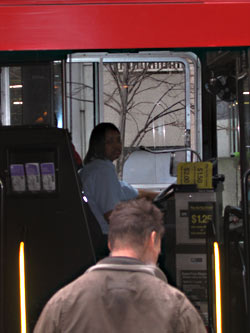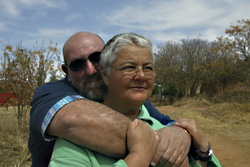Tom thought he was doing the right thing. During a layover at the Kent park-and-ride a few years ago, the Metro bus driver came upon a group of kids flashing a laser pointer in another driver’s eyes and threatening him with razor blades. The other driver told Tom that Metro HQ had instructed him to ignore the threats and continue driving his route. So Tom did the same. But when he returned to the park-and-ride, one of the boys was still there, so Tom collared him.
Tom called Metro to report that he had one of the boys and asked that supervisors send the police. Instead, he was told to let the boy go, then was suspended for a day without pay and forced to attend a day of retraining.
Since my story about lawlessness on Metro buses appeared [“Diesel Fuming,” March 7], I’ve spoken with a number of drivers who say that Metro management discourages well-meaning drivers from trying to make their routes safer. “They tie our hands,” says Tom (who, like most of the drivers I spoke to, asked to remain anonymous for fear of retaliation). “They don’t allow us to be creative, to use our common sense in a lot of cases, because they’re so worried about their image and lawsuits.”
According to Metro protocol, when an incident occurs on the bus, drivers are to radio a “coordinator” with a “request to talk.” Depending on the severity of the problem, the coordinator may forward the call to the transit police’s dispatch center, which may put out a call to officers. If transit police (all of them King County sheriff’s deputies) can’t respond, the call is routed to the police department of whatever city the bus is in.
Drivers aren’t allowed to call the police directly on their cell phones. Additionally, drivers are to remain in their seats “when possible,” according to the Metro operations manual. Violating these policies can earn the driver a “performance report” or P.R. Too many of these demerits, and a driver faces suspension or termination.
“The whole system expects us to take abuse,” says a 22-year Metro veteran I’ll call Susanna. “Spitting, hitting, weird little threats and innuendos, and you have to sit there, staring at their belt buckle, and take it. And if you don’t like it, then you become an even bigger target.” Drivers are not allowed to carry as much as a can of Mace to defend themselves.
“If I drove at night or on a scary route, I’d probably break policy,” says Lisa, who has driven for 11 years, so far without a serious threat. “But again, you’ve got 3,500 people, and we’re all different. If we were allowed to carry a knife or Mace, then somebody’s probably going to use it wrong. Honestly, there are no easy answers.” According to Lisa, the closest Metro comes to personal-safety training is telling drivers to pull over and open the doors when a problem erupts.
Asked to respond to this and other driver concerns mentioned in this story, Metro spokesperson Linda Thielke said all issues concerning safety and operations are addressed through a committee that involves managers, field supervisors, drivers, and union representatives. “The bus drivers do have a say in some of these policies as they’re being developed,” she says. “And they can always bring any concerns they have up to their supervisors about things that need to be changed in the policies if they have suggestions.”
Bad behavior on the buses is tolerated or ignored because drivers aren’t empowered to do anything about it, Susanna says. According to her, those who complain about their safety are admonished for not writing up more incident reports or calling coordinators. But too many calls or reports mark the driver as a troublemaker.
Glenn Ruth, who drove for Metro for 13 years before injuries sustained from two assaults while driving forced him to resign, says his reputation often preceded him when he called his coordinators. “‘Oh, it’s you again,’ they’d say. Or, ‘What the hell’s going on now, Glenn?’ You’re damned if you do and damned if you don’t.”
In July 2006, driver Anthony Woods famously wrestled a loaded gun away from a would-be robber on his bus. In response to his heroism, Metro put a letter in his file admonishing him for, among other things, leaving his seat. (The drivers union eventually got Metro to remove the letter.)
Twenty-seven-year Metro veteran John Henry Jones says his calls to coordinators have led to exchanges that border on the absurd. “They’ll ask, ‘Are they pointing the knife at you?’ Or, ‘Has he stabbed you yet?'” Jones says. “Imagine being in a situation like [Woods’]. Would you feel like answering all these questions?”
According to Jones, some drivers who can still be moved to protect their passengers do so without leaving any paper trail. “There’s been times where a woman was getting beat up, I have to physically intervene and remove this person myself and hope no one reports me,” says Jones. “Anything you do, it’s a risk. If it comes back to you, you’re setting yourself up to be fired. The people who won’t stand by and watch people get beat up, Metro will find them and weed them out.”
Susanna says she’s lost so much faith in the incident-reporting system that she’s resorted to calling Seattle cops on her cell phone when she needs help. Each time she does, she says, she receives a P.R. She also dutifully fills out three to five incident reports each week, usually for disturbances and destruction of her coach. “The drivers that aren’t having problems are the ones totally ignoring everyone and everything,” she says.
She doesn’t begrudge Metro for its policies. “I see their point, kinda,” she says. “If you get involved in this stuff, you become a part of it, and nobody wants to be a part of it. The only problem is, we’re hauling it. So how do you stay out of it when you’re the captain of the ship?”
hhsu@seattleweekly.com








